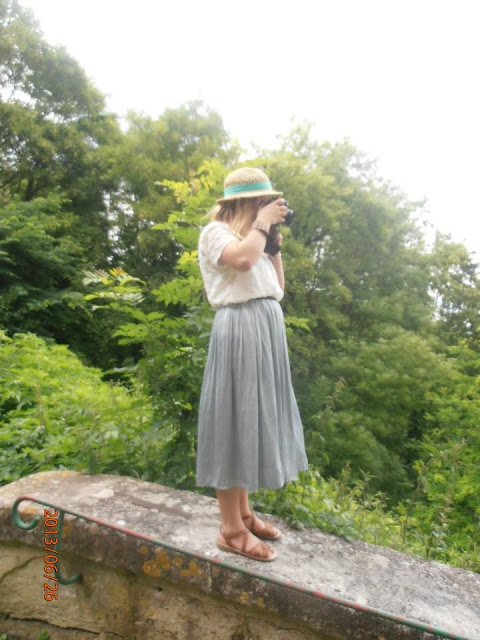Louveciennes and Musee de l'Orangerie
Yesterday (Wednesday 26th) the group went 30 minutes out of Paris to a little town called Louveciennes.
It was lovely and quiet, and filled with trees and birds and art history.
We observed places where recognised paintings were based off, and had a picnic lunch in a beautiful park.
Painting by Alfred Sisley, of the same street in the winter.
A view of Paris.
And a photo of me taken by a new friend, Olivia, as I was taking photographs of the view.
Today (Thursday 27th), one week into Paris, we went on a walk of some painting scenes, saw where Cartier-Bresson took his famous 'decisive moment' photograph, and then to the Musee de l'Orangie (where Monet's huge waterlily paintings are situated).
The walk was really lovely.
We stopped off at an amazing patisserie on the way (where a woman couldn't understand my attempt of French), and re-enacted famous paintings (such as 'Rainy Days') and photographs (the decisive moment).
(I didn't have my camera on me, so others have these moments and I'm yet to get the photos).
I really enjoyed the museum. Seeing Monet's huge works (which were painted over 10 years), was breathtaking.
The other works featured in the museum were also beautiful. I wrote down several pieces that I liked.
The other works featured in the museum were also beautiful. I wrote down several pieces that I liked.
I couldn't decide which of Monet's pieces I liked the most. Each time I looked at a piece I would find something new that I hadn't noticed earlier. I have concluded I have no favourite. As a whole, I thought the series was beautiful and breathtaking.
Renoir: Junes Filles au Piano (1892).
I really liked the use of textual colour and entwined brush strokes in this painting by Renoir. The background, in particular, is striking to me as his use of colour is particularly emphasised around the two girls. The subject matter is realistic in proportion, shape, and form but Renoir still uses interesting brush strokes to create texture.
Paul Cezane: Nature Morte, poire et pommes vertes
What I liked about this piece was the contrast of muted colours against the other paintings in the gallery (which were a lot brighter). I also liked how the blocks and thick brush strokes of tone change are used to create form. Along with this, the painting was quite textural (which is my favourite thing in artworks, and just generally anything really). Even though its simple subject matter, I think it has been painted in an interesting manner.
Cezane: Arbres et Maisons
In contrast to the previous work of Cezane, I like the warmth that this image lets out. The blotted colours remind of an autumn day as well as create a strong pattern by the strokes of the brush.
Picasso: composition paysans (1906)
This smaller image using what I perceived as ink and pastel and perhaps a sort of chalk on paper/cardboard was effective to me because it was completely textual (by materials) paired with fluid shapes and likes of the ink and skewed shapes and forms.
I'm not really sure what to interpret of the image.
At a first glance it looks like some kind of reverse man-angel-human taking a girl hiding behind a dead guy into the clouds.
I'm sure that's not at all right.
Picasso: L'Etriente (1903)
I liked this mostly because of the subject matter.
A moment of passion, or sorrow, or both I guess.
P.S: I am tired, and I have also completely forgotten how to write about artwork, so I'm not making too much of an effort, just jotting down some thoughts I guess.
.jpg)
.jpg)
.jpg)

.jpg)
.jpg)








No comments:
Post a Comment